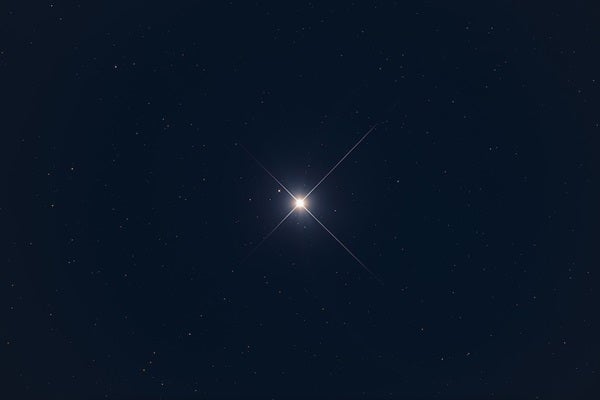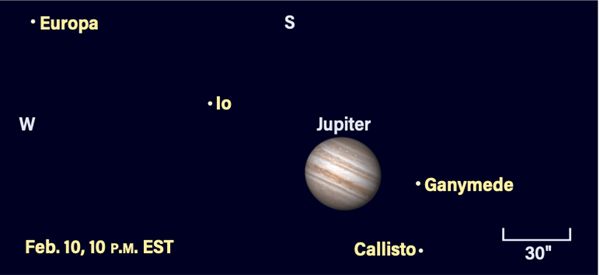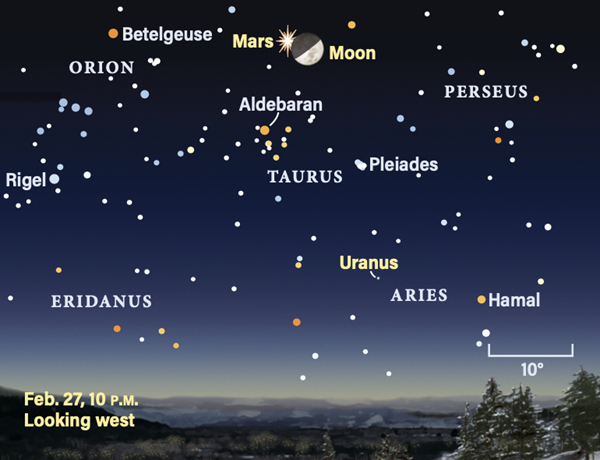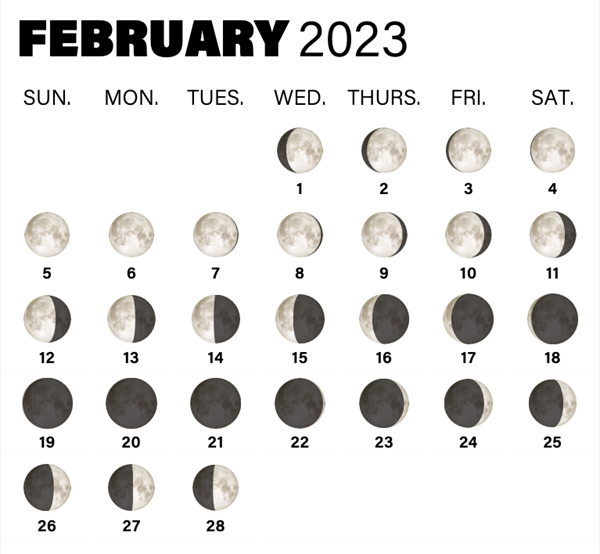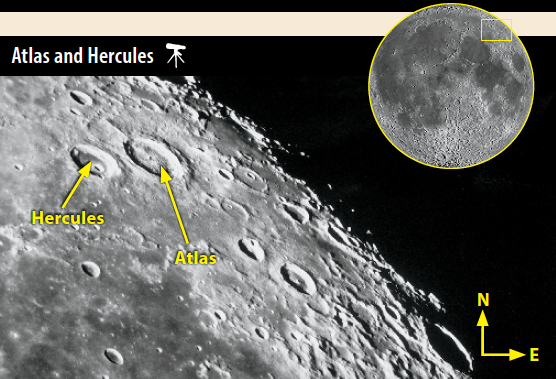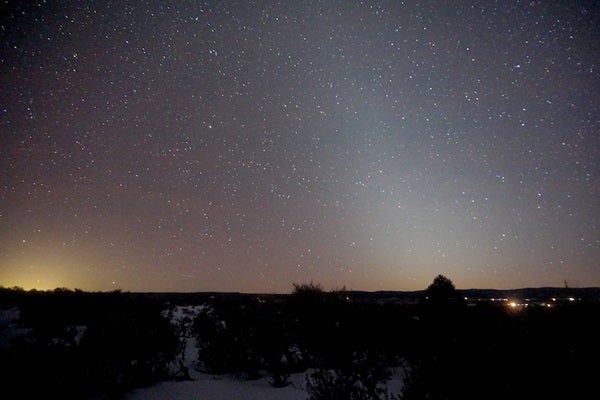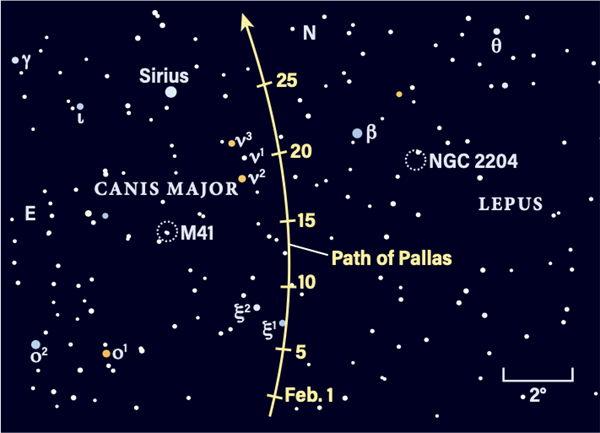Three bright planets are visible every evening in February, and two more can be spotted with binoculars. Venus, Jupiter, and Mars are strung across the western sky after sunset; the first two set earlier, while Mars remains long into the night. The scene is perfect for planetary observers with telescopes, offering plenty of features to enjoy. After Mars sets in the early hours after midnight, you’ll have to wait until the predawn hour to spot Mercury — catch it in the first week of the month for the best views, as it’s just past its greatest elongation from the Sun.
We begin with Venus and Jupiter, shining brilliantly in the southwestern sky this month. Standing nearly 29° apart on Feb. 1, watch each evening as Venus climbs upward and Jupiter descends until they almost meet on Feb. 28.
Venus is the brighter of the two at magnitude –3.9 all month. On Feb. 1, Venus sets two hours after the Sun. This places it 10° high in a dark sky an hour after sunset. A telescope reveals an 11″-wide disk that is 91 percent lit. As you follow Venus climbing through the month, its disk grows slightly to 12″ and the phase shrinks to 86 percent.
Wandering against the faint stars of Aquarius early in the month, Venus reaches the area of sky containing the much more distant Neptune. On Feb. 14, the pair stand some 33′ apart, the equivalent width of the Full Moon. Neptune is comparatively quite dim at magnitude 7.8. Binoculars will reveal it if the sky is dark enough and very clear near the horizon. Neptune stands northeast of Venus. Note two brighter 7th-magnitude stars west of Venus. If you can see these stars easily, Neptune will be within reach.
The following evening, Feb. 15, the planets’ positions are switched as Venus, closer to Earth, has moved 40′ northeast of Neptune’s location and crossed into Pisces. As you view the pair of planets, consider that Venus is only 1.4 astronomical units (AU) away, while Neptune is a staggering 30.8 AU distant. (One AU is the average Earth-
Sun distance.) Through a telescope, Neptune’s disk spans 2″ — near the resolution limit of small scopes — and its appearance will be strongly affected by the low altitude.
During the last half of February, Venus closes the remaining 14° gap to Jupiter. Jupiter stands in Cetus, crossing into Pisces on the 19th. On Feb. 21 and 22, a thin crescent Moon joins the pair of bright planets. On the 21st, Luna hangs 6° below Venus; the following evening, it’s adjacent to Jupiter, just three Moon-widths away.
On the last evening of February, Venus and Jupiter stand less than 1.3° apart, an attention-grabbing pair located low in the western evening sky. An hour after sunset, they stand nearly 20° high and remain visible until at least 8 P.M. local time, when they’ll be blocked by any trees or local buildings. The pair will sit closer together on March 1 — we’ll review that conjunction next month.
Jupiter is a fine target for telescopes of any size. Small scopes will easily reveal the four Galilean moons: Io, Europa, Ganymede, and Callisto shine from 5th to 6th magnitude. The disk of Jupiter, spanning 36″ on Feb. 1 and dropping to 34″ by Feb. 28, reveals a pair of dark belts straddling its equator. There’s more to see with larger telescopes: subtle details of dramatic atmospheric phenomena carried by the gas giant’s fast, sub-10-hour rotation period. Jupiter starts the month at magnitude –2.2 but quickly dims by 0.1 magnitude.
Usually, we see the Galilean moons strung out east or west of Jupiter. However, sometimes the moons appear in odd relative locations because of the tilt of their orbits with respect to our line of sight. Check out Callisto 30″ due north of Ganymede on Feb. 10, around 10 P.M. EST. Callisto lies on the far side of its orbit just past superior conjunction, while Ganymede is on the near side and heading toward inferior conjunction.
A pair of transits tell us a lot about the moons’ orbits. Observe Jupiter on both Feb. 13 and 17. On the 13th, look between about 7:22 P.M. and 8:00 P.M. EST to see Europa and its shadow. Check how far apart they appear. You can imagine where the Sun is located to cause the shadow to appear where it is. On the 17th, watch the planet from about 6:56 P.M. to 8:17 P.M. EST. Io and its shadow appear much closer together than Europa and its shadow did because Io’s orbit is smaller. The transit is already underway for Midwest observers as twilight descends.
Uranus is an easy binocular target all month, located in a sparsely populated region of southern Aries. Three 5th-magnitude stars provide a useful signpost to this distant planet. Look for the triangle of stars formed by Sigma (σ), Pi (≠), and Omicron (ο) Arietis. This triangle is 6° due north of Mu (μ) Ceti in the head of the Whale. Uranus is inside this triangle and moves northeast from night to night. By the last week of February, it lies roughly midway between Sigma and Pi. Uranus sets shortly after 11 P.M. local time at the end of month, so there’s lots of dark time to catch it. A telescope reveals its 4″-wide pale bluish disk.
Mars shines brightly in Taurus the Bull, where it has spent most of the winter. It’s well past its best but at magnitude –0.2, still outshines Aldebaran some 8° to its south on Feb. 1. Mars starts the month 10° due east of the Pleiades (M45) and slowly moves eastward each night.
Check Mars with binoculars on Feb. 10 and 11 for the possible appearance of a binocular comet (C/2022 E3 [ZTF]) nearby. If the comet gets bright enough, you may see very faint fuzzball 1.5° northeast of Mars on the 10th and less than 2° due south on the 11th.
Mars continues across northern Taurus and fades to magnitude 0.3. The month ends with Mars less than 5° southwest of Elnath (Beta [β] Tauri), the northern horn of the Bull. On Feb. 27, Mars stands about 1.5° east of a First Quarter Moon in the early evening. By midnight Eastern time, the Moon has wandered due north of Mars, with 1.1° separating them.
Mars is very small in telescopes and continues to shrink after its December peak. It spans 11″ on Feb. 1 and slims to 8″ by Feb. 28. Around 9 P.M. in the Central time zone, the following features lie on the Earth-facing hemisphere of Mars (determined for the mid-U.S.): Feb. 1: Tharsis and Valles Marineris; Feb. 8: Sinus Sabaeus and Mare Erythraeum; Feb. 15: Syrtis Major and Hellas; Feb. 22: Elysium and Mare Cimmerium; Feb. 28: Mare Sirenum, Amazonis, and Olympus Mons. Features will vary depending on the time you observe from your location.
Mercury appears low in the southeast before dawn. On Feb. 1, it stands nearly 4° high an hour before sunrise. Shining at magnitude –0.1, Mercury is a couple days past its greatest elongation west. It’s located in eastern Sagittarius near the Teaspoon asterism. If you can spy the planet through a telescope, it shows a 67-percent-lit disk spanning 6″.
A week later, Mercury has dropped to 1.5° high an hour before sunrise. It is now magnitude –0.1. By Feb. 14, it is brighter at –0.2 and visible 45 minutes before sunrise, quickly blending into the morning glow. Your final glimpse might be on the morning of Feb. 18, when a waning crescent Moon, just over a day from New, appears in the vicinity. Mercury sits 7° to the upper left of the Moon 30 minutes before sunrise.
Saturn is visible in the west for less than an hour after sunset in early February. It reaches conjunction with the Sun on Feb. 16 and will reappear in the morning sky next month.
Rising Moon: Flooded and floodlit
Thanks to orbital good timing, we can saunter along the distant shoreline of the giant Ocean of Storms in the Moon’s northwest. Often it is tilted out of view or only visible after a midnight moonrise, but this month, the white highlands are visible for a whole week starting at Full Moon.
On the evening of the 4th, the prominent horseshoe-shaped crater Eddington lies near the day-night terminator line, due west of blazing Aristarchus. Eddington’s southern half lies buried under a sea of lava. A neat wrinkle ridge links two nearby sharp-edged craters.
Sunday evening (the 5th) gives us our first view of Einstein, west and a little south of Eddington. Slightly bigger, a respectable 125 miles across, Einstein is a battered ring with a secondary crater in its middle. But it won’t look like a typical crater this night because it lies edge-on to our line of sight. Look right on the limb for three bumps, which are a profile of the crater rim with its central peak. The outer two high spots are a bit farther apart than Eddington’s width.
With each successive night, the Moon’s western limb appears to roll slightly toward us, transforming the view from edge-on to a shallow angle, so that by the 9th, Einstein’s inner crater is noticeable, surrounded by some darker lava that flooded the outer crater’s interior. Use a filter to cut the glare, such as a cross-polarized pair that will allow you to dial in the amount of reduction. Alternatively, a deep-blue filter, sunglasses, or increasing the magnification are good ways of managing the light. The sequence nearly repeats next month, starting March 5th.
Meteor Watch: Soft glow after sunset
Meteors are few and far between during February, with no major showers. A minor background rate of a handful of meteors per hour is visible nightly. On Feb. 11, about a week after the Moon passes Full, look toward the western horizon for the zodiacal light. This cone-shaped glow is aligned with the ecliptic and is noticeable if you cast your eyes to and fro along the horizon. The light is sunlight reflecting off solar system debris left by ancient comets.
Pick a countryside observing location where the western horizon is very dark, absent of any streetlights near or far. An hour or so after sunset, the zodiacal light becomes visible. It lasts more than an hour, slowly setting as the evening progresses. You can increase your chances of seeing the zodiacal light by gaining elevation. This glow is a regular occurrence from any mountain vantage point with a view to the west.
Comet Search: All abuzz
With so much to experience this month, try observing Comet C/2022 E3 (ZTF) each clear night, no matter the Moon or light pollution. Rivaling the brightness of summer’s M13 cluster at 5th magnitude, ZTF could be the best comet of the year. It’s visible in the evening, has two tails, changes shape, and it really moves.
ZTF zips at 6° each night as February starts, when it is closest to Earth. It shifts obviously in just 10 minutes at the eyepiece. The comet then appears to decelerate to 3° per night by the 8th and slows to 1° each evening as March opens. It’s all a trick of perspective.
The comet sails through photogenic dark lane starfields by Friday the 10th and passes Mars,
which lies at twice ZTF’s current distance. For Perseverance, the 6th-magnitude comet appears 2° from magnitude –2 Earth in the martian sky.
Small scopes from the suburbs should show a narrow fan of dust getting broader as ZTF fades by a couple of magnitudes into New Moon. Switch to country skies if you can. Twelve-inch scopes ought to reveal some green in the coma, while imagers might get a blue gas tail lining the sharply defined south edge.
Farther north, magnitude 10 C/2020 V2 (ZTF) gets traded from Cassiopeia to her daughter, Andromeda. And observers south of the equator can watch 7th-magnitude C/2017 K2 (PanSTARRS) skirt a few degrees from the Small Magellanic Cloud.
Locating Asteroids: Pallas and the pooch
The No. 1 dog, Canis Major, plays host to the No. 2 asteroid, Pallas, this month. Suitable for small scopes from the suburbs, Pallas glows at magnitude 7.7 just a short jump from the blazing blue-white Sirius. Thankfully, the main-belt asteroid lies so far south of the ecliptic that as the Moon passes way on the north side, Luna’s light halo never interferes.
Despite the richness of the winter Milky Way, these stars are more distant than those visible in summer. Hence, they are fainter, allowing Pallas to stand out — so much so that nothing beats it until the 7th, when it slips through the field of 4th-magnitude Xi1 (ξ1) Canis Majoris. On the 22nd and 26th, two loose clutches of stars provide a reference to highlight Pallas’ displacement in an hour.
Potato-shaped Pallas spans some 325 miles and was discovered by Heinrich Wilhelm Olbers in 1802, while he was painstakingly comparing the sky against star charts.

